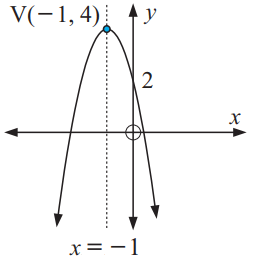FINDING THE TURNING POINT OF A QUADRATIC FUNCTION
Subscribe to our ▶️ YouTube channel 🔴 for the latest videos, updates, and tips.
What is vertex ?
The graph of the quadratic function is called a parabola. The point where the graph turns is called the vertex.
If the graph opens upward, the y-coordinate of the vertex is the minimum and the graph is concave upwards.
If the graph opens downward, the y-coordinate of the vertex is the maximum and the graph is concave downwards.

To find vertex of a parabola, we have two different ways.
1) Using completing the square
2) Using formula
Find the turning point of the quadratic functions given below.
Problem 1 :
y = x² + 7x + 10
Solution :
y = x² + 7x + 10
Using completing the square method :
Turning point is at (7/2, -9/4).
Using formula :
y = x² + 7x + 10
Here a = 1, b = 7 and c = 10
|
x = -b/2a x = -7/2 |
When x = -7/2 y = (-7/2)² + 7(-7/2) + 10 y = (-7/2)² + 7(-7/2) + 10 y = (49/4) - (49/2) + 10 y = (49 - 98 + 40)/4 y = -9/4 |
Turning point is at (7/2, -9/4).
Problem 2 :
y = x² + x - 12
Solution :
y = x² + x - 12
Using completing the square method :
The turning point is (1/2, -49/4).
Using formula :
x-coordinate of turning point is x = -b/2a
Here a = 1, b = 1 and c = -12.
|
x = -1/2(1) x = -1/2 |
When x = -1/2 y = (-1/2)² + (-1/2) - 12 y = (1/4) - (1/2) - 12 y = (1 - 2 - 48)/4 y = -49/4 |
The turning point is (1/2, -49/4).
Problem 3 :
y = 4x - x²
Solution :
y = - x² + 4x
Using completing the square method :
y = - [x² - 4x]
y = - [x² - 2⋅ x ⋅ 2 + 2² - 2²]
y = - [(x - 2)² - 2²]
y = - [(x - 2)² - 4]
y = - (x - 2)² + 4
(h, k) ==> (2, 4)
Using formula :
|
x = -b/2a x = -4/2(-1) x = -4/-2 x = 2 |
When x = 2 y = 4(2) - (2)² y = 8 - 4 y = 4 |
So, the turning point is at (2, 4).
Problem 4 :
y = -2x² - 4x - 2
Solution :
Using completing the square method :
y = -2[x² + 2x + 1]
y = -2 [x² + 2⋅ x ⋅ 1 + 1² - 1² + 1]
y = - [(x + 1)² -1 + 1]
y = - [(x + 1)² + 0]
(h, k) ==> (-1, 0)
Using formula :
x = -b/2a
Here a = -2, b = -4 and c = -2.
|
x = 4/2(-2) x = -1 |
y = -2(-1)² - 4(-1) - 2 y = -2 + 4 - 2 y = 0 |
So, the turning point is at (-1, 0).
Problem 5 :
y = 4x² - 24x + 36
Solution :
Using completing the square method :
y = 4[x² - 6x + 9]
y = 4 [x² - 2⋅ x ⋅ 3 + 3² - 3² + 9]
y = 4[(x - 3)² -9 + 9]
y = - 4[(x - 3)² + 0]
y = - 4(x - 3)² + 0
(h, k) ==> (3, 0)
Using formula :
Here a = 4, b = -24 and c = 36
|
x = 24/2(4) x = 24/8 x = 3 |
y = 4(3)² - 24(3) + 36 y = 36 - 72 + 36 y = 0 |
So, the turning point is (3, 0).
Problem 6 :
y = x² - 4x + 1
Solution :
Using completing the square method :
y = [x² - 4x + 1]
y = [x² - 2⋅ x ⋅ 2 + 2² - 2² + 1]
y = [(x - 2)² -4 + 1]
y = [(x - 2)² - 3]
(h, k) ==> (2, -3)
Using formula :
Here a = 1, b = -4 and c = 1.
x = 4/2(1)
x = 4/2
x = 2
y- Intercept: (x = 2)
y = (2)² - 4(2) + 1
y = 4 - 8 + 1
y = -3
So, the turning point is at (2, -3).
Problem 7 :
y = x² + 4x - 3
Solution :
Using completing the square method :
y = [x² + 4x - 3]
y = [x² - 2⋅ x ⋅ 2 + 2² - 2² - 3]
y = [(x - 2)² -4 - 3]
y = [(x - 2)² - 7]
(h, k) ==> (2, -7)
Using formula :
Here a = 1, b = 4 and c = -3.
|
x = -4/2(1) x = -2 |
y = (-2)² + 4(-2) - 3 y = 4 - 8 - 3 y = -7 |
So, the turning point is at (-2, -7).
Subscribe to our ▶️ YouTube channel 🔴 for the latest videos, updates, and tips.
Recent Articles
-
Finding Range of Values Inequality Problems
May 21, 24 08:51 PM
Finding Range of Values Inequality Problems -
Solving Two Step Inequality Word Problems
May 21, 24 08:51 AM
Solving Two Step Inequality Word Problems -
Exponential Function Context and Data Modeling
May 20, 24 10:45 PM
Exponential Function Context and Data Modeling